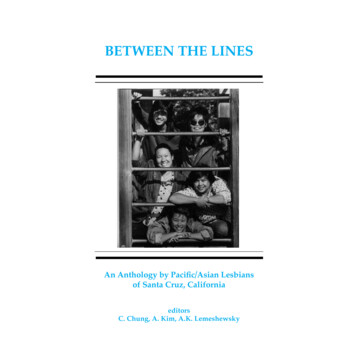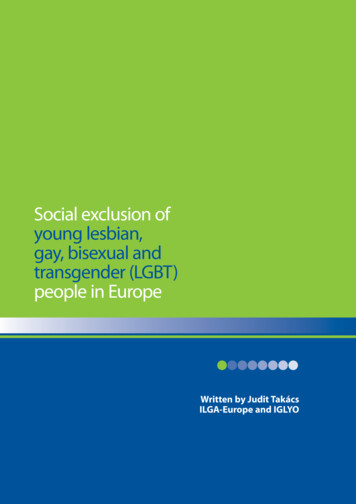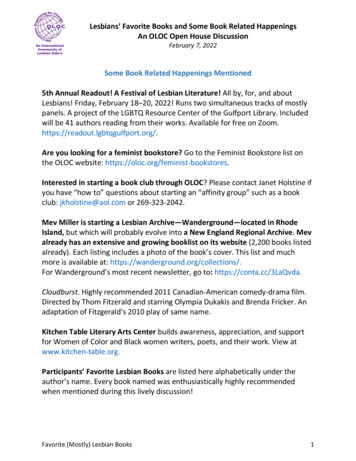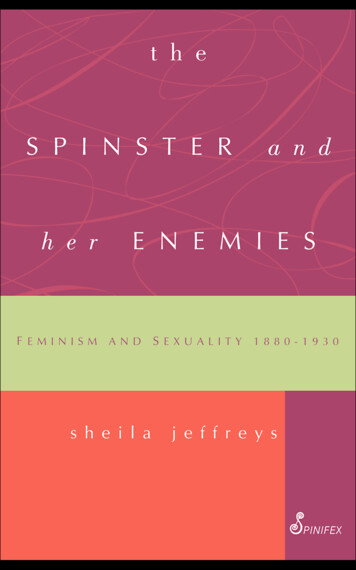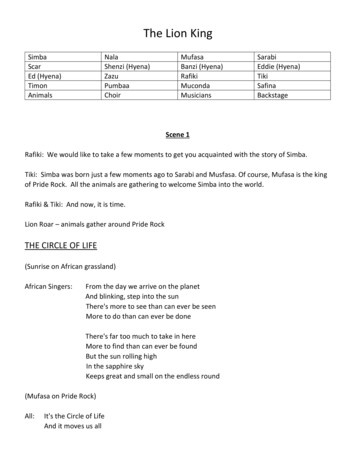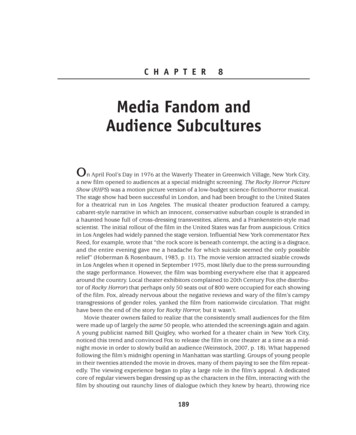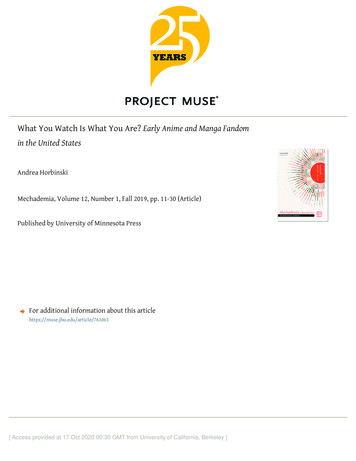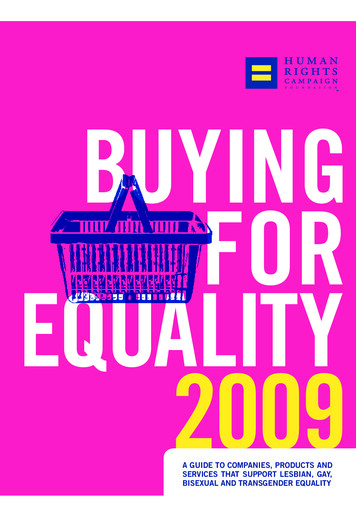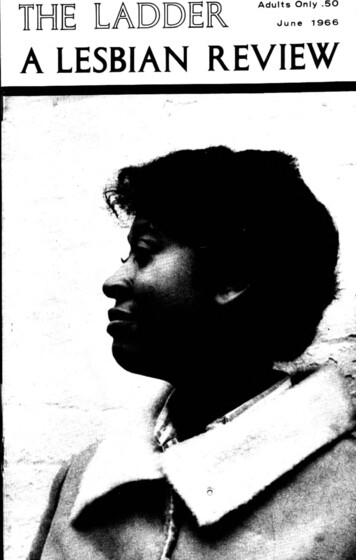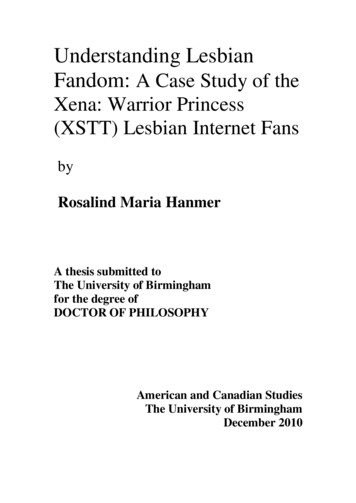
Transcription
Understanding LesbianFandom: A Case Study of theXena: Warrior Princess(XSTT) Lesbian Internet FansbyRosalind Maria HanmerA thesis submitted toThe University of Birminghamfor the degree ofDOCTOR OF PHILOSOPHYAmerican and Canadian StudiesThe University of BirminghamDecember 2010
University of Birmingham Research Archivee-theses repositoryThis unpublished thesis/dissertation is copyright of the author and/or thirdparties. The intellectual property rights of the author or third parties in respectof this work are as defined by The Copyright Designs and Patents Act 1988 oras modified by any successor legislation.Any use made of information contained in this thesis/dissertation must be inaccordance with that legislation and must be properly acknowledged. Furtherdistribution or reproduction in any format is prohibited without the permissionof the copyright holder.
AbstractThis thesis is written to promote and pursue an understanding of lesbian fandom andits function on the Internet. It will demonstrate how a particular television text Xena:Warrior Princess (X: WP) and a dedicated online fandom „xenasubtexttalk‟ (XSTT) ofdiverse lesbian fan membership gained empowerment and agency through their fanpractices. Since the screening of the television fantasy series X: WP (1995-2001),there has been a marked increase in academic enquiry into lesbian fan culture on theInternet. This thesis contributes to the lesbian spectatorship of fandom with a specificinterest in online fandom. This research suggests there are many readings of X: WPand the dedicated websites set up to discuss the series have increased during and postthe series broadcast period. This study explores the contradictions, the gaps, and thedifferences between fan responses to the series, especially the lesbian discourse andfan fiction that developed during and after the television series ended. Thisinvestigation suggests that fan scholarship can obtain a new insight into lesbianInternet fan practices as a virtual space producing new lesbian fan online identitiesand discourses that challenge traditional forms of lesbian fandom. It does this bypresenting three distinct, significant and interrelated layers of lesbian online textualengagement. While interrelated, these layers are separate and important as they eachreveal new lesbian online fan performances of identity that challenge traditionalperformances of reading and writing habits of lesbian fans.
DedicationThis thesis is dedicated to my beautiful Buddhist son Ethan, aged five, who was bornin the midst of all my anxiety around this research and whose strong life force andbeautiful smile kept me going throughout my journey.
AcknowledgementsThis thesis was completed by self-finance and with the support and help of thesepeople. I am particularly grateful to the numerous members of staff from LondonMetropolitan University who have supported me and who over many years haveoffered me encouragement and insights into how to “survive a PhD”. I would like tothank these people whom I have had the pleasure to work with on occasion: JonathanWright, David Hanson-Miller and Mike Chopra-Gant, and not forgetting GordanaUzelac who proof- read a chapter in the early days of my transfer, and Kim Blake whoread and discussed my work with me. Thank you to my first dyslexic tutor TanyaZybatz and to my subsequent dyslexic tutors Dianne Poole and Sally Ratcliffe fortheir support.Thanks go to Soula Timotheou and Eileen Lanigan the staff in the ComputerDepartment and Jason Raymond who “bailed me out” on many occasions with theirhighly skilled technical support. I am grateful to Dr. Millie Williamson, Professor LynThomas and Professor Ken McKinnon who supported my supervision during the earlystages of my study at the University of North London and London MetropolitanUniversity and especially to Millie for giving me the courage to pursue thisinvestigation in the first place. I would like to give further thanks to Michele Aaronfrom the University of Birmingham who supervised the thesis with patience andrigour believing in me throughout. I owe much to her intellectual and professionalguidance and the enormous amounts of understanding shown to me on my journey.
Table of ContentsIntroduction . 1Chapter One . 8Chapter Two . 9Chapter Three . 10Chapter Four . 11Chapter Five . 11Chapter Six. 12CHAPTER ONE: THE KEY DEBATES WITHIN THE HISTORY OFCONTEMPORARY FANDOM. 13From Traditional Fandom To Online Usernet Fandom . 16The Productive Text in Fandom . 19Resistant Reading . 22Ethnography as Agency . 24Audience Research and Ethnography . 25The Fans‟ Cultural Capital as Agency . 28Feminist Interventions into Audience Research . 34Telefeminism . 44The Significance of the Science Fiction Fans in Contemporary Fandom . 47The Synergy of Television the Internet and Online fandom . 49CHAPTER TWO: A METHODOLOGICAL APPROACH TOWARD A NEWDISCOURSE IN LESBIAN FANDOM . 60The Case Study . 72Recruitment, Methods and Framework . 84Types of Data Gathered . 92Sample Limitations. 93
Charting Themes and Theories . 94CHAPTER THREE: THE INVALUABLE ‘OPEN SECRET’ OF XENA:WARRIOR PRINCESS . 99The Fans‟ Stake in the Open Secret . 101The Commodification of the Open Secret . 105The Politicisation of the XSTT Fans within the Open Secret. 111The Postmodern Text of XSTT Fandom . 117The Final Episodes of X: WP. 120Synopsis of “Friend in Need: Part 1” . 121Synopsis of “Friend in Need: Part 2” . 124The On-Screen Death of Xena . 126CHAPTER FOUR: THE CULTURAL STRUGGLE FOR MEANING FOR THELESBIAN FAN . 137XSTT Internet Journeys with Xena . 138„Feminist Camp‟ and Masquerade in relation to XSTT . 155“The Bitter Suite” (1998) . 158“The Quest”(1997) . 164CHAPTER FIVE: LESBIAN INTERNET FAN FICTION . 172The Studio Poaching of Melissa Good. 176S/lash Fiction Lesbian Fandom . 178Altfic. and Lesbian Fan Fiction . 188A fan story: „Why Joxer?‟. 195A fan story: „Amazon Pleasure‟ . 205CHAPTER SIX: THE DEVELOPMENT OF LESBIAN ONLINE FAN FICTIONAND ITS BETA READERS . 220Über: Cross Over Fan Fiction Stories . 227The Function of Online Reviewers and Beta Readers . 230
Pornography, Erotica and Romance within Lesbian Fan Fiction . 238The Use of Disclaimers in Online Fan Fiction . 250The Never-ending Fan Fiction . 252CONCLUSION . 256BIBLIOGRAPHY . 260Original Airdates of Xena: Warrior Princess Television Episodes . 275APPENDIX ‘A’ . 277Fan Email . 277Email from cabinngirl one of the gatekeepers . 277First Posted Message dated 8/3/2001 . 277Second Posted Message referring to break in research . 278APPENDIX ‘B’ . 279Participant Fans from Xenasubtexttalk (XSTT) Online Fandom . 279APPENDIX ‘C’ . 281Questions used for each of the Fans interviewed . 281APPENDIX ‘D’ . 283A Fan Story: „Healing Heart‟ by reneeg 33 . 283APPENDIX ‘E’ . 290Special Anniversary Issue of Ms. . 290APPENDIX ‘F’ . 291Wengraf's paper system supporting inferences to Models – A Sample . 291APPENDIX ‘G’ . 296Node Coding Report for NVivo Software sample . 296APPENDIX ‘H’ . 299Sample of Membership page from Xenasubtextalk (XSTT) Fan Club . 299
APPENDIX ‘I’ . 300Messages from Yahoo Board Posting from XSTT – A Sample of a Fan‟s Posting . 300APPENDIX ‘J’ . 302Message by email from XSTT – A Sample of Correspondence with a Fan . 302APPENDIX ‘K’ . 303An Early Table (1996) Indicating the Growth of X: WP Fan Fiction . 303
List of IllustrationsFigure # 1. Xena with arrows. Image (2001) p.124.http://www.whoosh.org/issue11/silver1.html- .Figure # 2. „The Agony and the Ecstasy‟ image of painting by Guido Reni (1610) ofSaint Sebastian: featured in „Arts Spotlight‟ (Arrows of Desire) written by CharlesDarwent in The Independent on Sunday 10 February 2008: 32-33. p.124.Figure # 3. Xena/Gabrielle Kiss Image (2001) p.135.http://www.whoosh.org/issue17/meister1.html- .Figure # 4. Xena/Gabrielle Kiss Image (2001) .Figure # 5. The Ladder newsletter image (2005) p.223.http://www.people.ucsc.edu/ rosewood/writing/essays/the%20laddercomplete.html.
1IntroductionThis thesis offers a lesbian and feminist cultural reading of Xena: Warrior Princess(X: WP 1995-2001) and its lesbian Internet fandom from an online community„xenasubtextalk‟ (XSTT 1998-present). In this online arena, three levels of textualengagement and discourse develop. The first layer of discourse is based on the subtextembedded in the text of the television series. For fans, the subtext is an „open secret‟of a lesbian relationship between the two main characters of the television series. Thesecond layer is about discussions of this and is revealed and developed through thefans‟ interviews, emails and bulletin board postings. This discourse relates to the opensecret of the subtext and results in some of the fans‟ “coming out” narratives, rites ofpassage, and confessional narratives in this discourse. Finally, the third layer oflesbian discourse is created through the lesbian fans‟ Internet production of fan fictions/lash writings about the two main characters of the series and their intimate sexualrelationship. These three narratives reflect the fans‟ lived experiences which aredemonstrated throughout the thesis. Lesbian Internet fans re-read the television text ofX: WP; appropriate the subtext, and discuss it in the online forums, and, finally, someof the lesbian fans from the XSTT lesbian Internet fandom write, publish, anddistribute Internet fan fiction through the Xenaverse 1. The Xenaverse is an extensionof the diegetic world of the show and this is the term I shall use to refer this widercommunity of fans. The three layers of lesbian discourses develop together andseparately. They overlap and intersect as they are performed online thus becomingpart of the lesbian Internet fans‟ new online fan identities.1„Internet fan culture is so intrinsic to the series that aficionados have coined the term „Xenaverse‟ todescribe the virtual territory that has evolved around and includes the programme. The Xenaverse is avirtual universe encompassing everything relating to X: WP‟ (Gwenllian-Jones, 2000, p.10).
2The online club XSTT was set up to discuss the show‟s subtext and was run by lesbianfans. In July 2001, The Advocate, a well-known American lesbian and gay magazinenamed the club XSTT as one of the top five in X: WP subtext sites. Crucial to theunderstanding of the development of lesbian Internet fandom is the subtext or „Xena‟ssubtext “talk” in the title of the club „xenasubtexttalk‟ or XSTT.When Renaissance Pictures premiered X: WP as a spin-off from Hercules: theLegendary Journeys in September 1995, never could the commercial, cultural, andglobal triumph of this fantasy narrative have been imagined. MCA/Universal TV andMCA International went on to syndicate the show. The lesbian fans‟ objects offandom are the two female protagonists of the X: WP series, Xena and Gabrielle. Therole of Xena, the main protagonist, is played by Lucy Lawless, while the role ofGabrielle, her companion, is played by Renée O‟Connor. The storyline follows theaction adventures of this warrior princess, Xena, whose violent past does not allowher any peace of mind. Xena‟s mission is to try to make amends for all the violent actsshe has committed in the past as a warlord. Accompanied by Gabrielle, she travelsacross many lands confronting obstacles on the way to absolve her past and finallygain salvation. The television series did not have an explicit subtextual messageduring the broadcast of the first few episodes. However, it did attract a small onlinelesbian audience at this stage; but later on in the first season, a bridge between theproducers of the series and a developing lesbian Internet fandom began to emerge. Atthis stage, a self-identified “out” lesbian producer Liz Friedman was hired. Friedmanwho had worked as an associate producer on the Hercules: the Legendary Journeys(1995-1998) helped enhance the magnetism of the X: WP show to the online lesbian
3fans by encouraging the creators and writers to build upon the subtext of the show.Once the television company was aware of that its online audience consisted largelyof a lesbian Internet community, the direction of the series changed forever.X: WP became the first television series of its kind to actively encourage lesbianonline fandom. After every show was aired, the audience‟s attention was drawn to theshow‟s official online site which was now advertised in the final credits of the series,„Xena was one of the first television shows to promote website use, advertising itswebsite via Universal Pictures at the end of every episode‟ (Ross, 2008, p.38). Afterseason two, the lesbian online fan audience was courted and targeted by the producersof the series. This culminated in the Studio requesting a lesbian Internet fan to writefor an episode of the show, and I shall discuss this more in chapter five.Initially, the show appealed to a diverse section of fans many of whom weretraditional fans of fantasy and adventure. However, this changed when the Internetenabled lesbian fans who traditionally went unnoticed in fandom to come together inlarge numbers as a virtual community to develop their discourses around this show.Alongside the Studio‟s official website, XSTT developed as a meeting place or spaceto discuss what many lesbian fans perceived as the subtext of the television series. Inthis context, the subtext is the sexual intimate relationship between Xena and hercompanion, Gabrielle.The purpose of this thesis is to understand lesbian fandom of X: WP and its migrationfrom traditional forms of fandom to lesbian Internet fandom and its development ofnew lesbian fan identities. I will analyse the discourses of XSTT fandom by using a
4small case study of fourteen fans belonging to this particular lesbian online fan club.This study was carried out over a period of twelve months and sequential interviewstook place online.I have used a qualitative hybrid methodology that combined participant observation,ethnography, and online interviews. This combination of research methods constantlydemanded review due to the diversity of the fans, as well as the fast-changing onlinetechnologies. The result, however, was a reflective and unique synthesis of researchmethods, which was innovative for its time (2001). In order to understand the fans‟appropriation and consumption of the text and their communication through what Isuggest is a new discourse, it is imperative that the process of developing their off andonline social and cultural identities be recognised as part of the anxieties and tensionsthat their confessional narratives sometimes demonstrate when discussing their objectof fandom. So, while agreeing with the broader frameworks of critical analyses withinaudience research, this study's first commitment is to the fans as social subjects andtheir performances and experiences, remembering as Miller & Glassner point out:Those of us who aim to understand and document others' understandingschoose qualitative interviewing because it provides us with a means forexploring the points of view of our research subjects, while granting thesepoints of view the culturally honoured status of reality (1997, p. 100).As this thesis captures the beginnings of online research, I suggest that this aspect hasits role to play in the study of lesbian Internet fandom. It should be noted that thediscussions, conversations and “chats” online were recorded in real-time and becauseof this, they retain their potency and freshness (yet are inevitably dated within thehistorical context). The journeys and life experiences of the fans also explore manytimeless issues but remain particular. These interviews and studies offer original and
5determining insights into the development of lesbian online fandom in the relativeinfancy of the Internet, and, as such, offer a unique, significant contribution to lesbianonline fandom research. This was an exciting time to research the new and expandingonline worldwide web. I hope that my observations and challenges to create a hybridmethodology will encourage future researchers to explore new ways of creating onlinepractices of qualitative research.I chose the fans for the study at random or rather they chose to come forward; thesewere the fans who responded to the bulletin board postings about my research. Yet,after many visits to the online fan site, I noted that of the three hundred and moremembers, this fandom was a heterogeneous group. The sample group I interviewedconsisted of old, young, married, single, bi-sexual, heterosexual, previouslyheterosexual, lesbian, potentially lesbian, gay, disabled, able-bodied, and singleparents. All these fans belonged to the XSTT online fandom. (More detail about thesefans is given in the methodology chapter of the thesis.) I believe this informationhelps bear out my explanation of the heterogeneity of the sample.I have included in my sample of discussions taken from my online investigations a fanwho was involved in domestic violence: a young fan who had very basic educationand little employment prospects; a fan who was in denial about her same-sexattraction as well as being oppressed by her religious upbringing; a fan who was badlyburned in a fire and was confined to a wheelchair and living in a rehabilitation unit atthe time of the interviews; a fan with four children who left her marriage of twentyfive years taking her children to travel a thousand miles and live with another femalefan, and a young fan whose writing of fan fiction developed along the same lines as
6her sexual identity and its transformation. I will show how these different readingsfrom these varied fans and their fan practices contribute to larger questions ofpersonal transformation, building interactive identities, empowerment and agency forthe lesbian Internet fan. I will also demonstrate how this leads to the development ofthe third level of lesbian discourse that demonstrates a challenge to the traditionalnotion of a lesbian fan identity and lesbian fan practice such as fan fiction writing.What is crucial in this study is that the television series of X: WP cuts across a numberof genres such as action, buddy, romantic, comedy, fantasy, feminist, women‟s series,soap operas (serialised) and therefore it cannot be critiqued simply in terms oftelevision. I will suggest first that the lesbian subtext is appropriated by the XSTTlesbian Internet fans. I will then look at how it is read and how this reflects andrecognises real life situations for the lesbian fans. I will go on to explain how a sectionof lesbian online fandom developed through the XSTT fan club, and how, through thefans‟ Internet responses, the lesbian fans of XSTT were drawn to particular X: WPepisodes in their discussions. Finally, I will discuss the production and distribution ofthe lesbian Internet fans‟ erotic and s/lash fiction writings online. I will investigatehow these all grew from fandom such as that found in XSTT and the Xenaverse.The fans mentioned in this thesis, I suggest, have their own personal individual andcollective journeys within their chosen path of the fan club. According to NoelleCollier, Christine Lumadue and H. Ray Wooten „Lesbians in the process of sexualidentity formation look to social contacts for information about and the validation oftheir developing lesbian identities‟ (2009, p.582).
7In this study, the subtext definition adheres specifically and strictly to Xena‟s andGabrielle's sexual relationship. The context in which a lesbian subtext is used withinX: WP was first defined as having been given a special “Xena twist” on theAlternative TV news group's website 2 , sometime during the show's first season.Alternative TV was set up to support the subtext being developed by Internet fangroups such as XSTT. With regard to the term, Xena twist, this was used to describeX: WP production team‟s unusual practice of intentionally placing subtle indicationsof a lesbian relationship between Xena and Gabrielle into the show. X: WP is„groundbreaking in that it provides an example to creators of television programmesof a way to make use of the space inherent in television texts, to present issues ofsexual and gender diversity, and it provides audiences with the possibility of thinkingabout sexual orientation in a more fluid way that transcends rigid identity categories‟(Bennett, 1999, p.1) 3.In addition to textual analysis, a number of theoretical perspectives such as audienceresearch, ethnography, qualitative research, and discourse analysis will be used tounderstand the concept of constructing a new lesbian online fan identity. It should beacknowledged that this case study of European and North American fans iscomparatively small: I will not be presenting my data as empirical evidence of how„all‟ lesbian fandom operates online. Rather, I solicit a consistent series of detailedresponses from my participants, enabling the validation of this small case study tofurther inform our understanding of lesbian Internet fandom in general. It is importantto emphasise that for this investigation, the fans‟ online pseudonyms are used and ISee more information on the „Xena twist‟ by reading „Xena: The Subtext FAQ‟ for alt.tv.xenaXenite.Org 2008-05-27 [online]. http://www.xenite.org/faqs/subtext.html [Accessed 12 September2008].3See Bennett, K.E. (1999) „Xena: Warrior Princess: Desire Between Women and InterpretiveResponse‟ [online] „Xena‟ http//www.drizzle.com/Kathleen/xena/html [Accessed June 2001].2
8am stating that the practices of online fandom are now in the public domain, and canthus be viewed at any time. Authenticity is discussed in more detail in themethodology chapter, but it is important to state that available guidelines at the timeof my research were basic and a rarity 4.All the fans‟ conversations remain unaltered except that the font has been changed to„Times Roman‟ for easier reading. Most of the conversations took place in real timethrough the instant messenger service of the fan club XSTT. The spelling andgrammatical errors will remain as part of the lived experiences of the fans and tocontribute to the illustration of the immediacy of their online personas. My ownspelling mistakes and grammatical errors are included in the data gathered. I wouldnow like to set out a brief summary of what chapter one contains, and how thediscussions and literature reviews of traditional and contemporary fandom are integralto an understanding of the broader historical perspective of lesbian Internet fandom.Chapter OneThe literature review of chapter one will examine the key debates within thecontemporary history of fandom as fandom moved online and traditional notions ofconsumption and production were challenged. Thus, the classic cultural studies‟expression of fan practice based on the Marxist model no longer holds credence giventhe age of media convergence. (Marx‟s theory of historical development suggests thatthe mass media follow the gratification of the dominant class and therefore reflect4While there is now an increased offering of guidelines for the online researcher, during my studymany issues were experienced trying to get written consent. Chris Mann and Fiona S
This thesis offers a lesbian and feminist cultural reading of Xena: Warrior Princess (X: WP 1995-2001) and its lesbian Internet fandom from an online community „xenasubtextalk‟ (XSTT 1998-present). In this online arena, three levels of textual engagement and discourse develop. The first layer of discourse is based on the subtext

